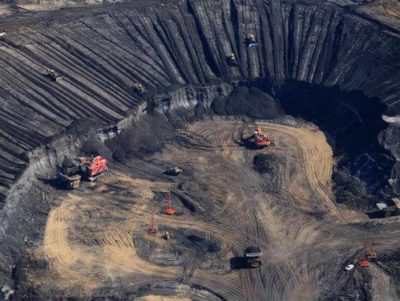Colossal fossil ExxonMobil has dropped virtually all its tar sands/oil sands holdings from its list of recoverable assets, and its Canadian subsidiary Imperial Oil followed suit by cutting a billion barrels of bitumen from its inventory, in what Bloomberg News calls a “sweeping revision of worldwide reserves to depths never before seen in the company’s modern history”.
Exxon reduced its estimate of recoverable reserves to 15.2 billion barrels world-wide as of December 31, Bloomberg reports—still a massive quantity, but far last than the 22.44 billion barrels it reported just a year ago. In the tar sands/oil sands, “the company’s reserves of the dense, heavy crude extracted from Western Canada’s sandy bogs dropped by 98%,” the news agency adds.
On the same day, The Canadian Press writes, Imperial cut its estimate of its “proved plus probable bitumen reserves” to 4.46 billion barrels, down from 5.45 billion a year earlier.
The two companies previously announced write-offs of up to US$20 billion for Exxon and C$1.2 billion for Imperial.
“Proved” or “proven” reserves have a specific meaning in fossil industry financing—in contrast to the total resource a company has discovered, proven reserves “refer to the quantity of natural resources a company reasonably expects to extract from a given formation,” Investopedia explains. To fit the definition, the resource must have “a 90% or greater likelihood of being present and economically viable for extraction in current conditions.”
It’s largely the deteriorating economic conditions the industry faces that led to Exxon’s and Imperial’s epic write-down this week.
“The pandemic-driven price crash that rocked global energy markets was the main driver of Exxon’s reserve downgrade, along with internal budget cuts that took out a significant portion of its U.S. shale assets,” Bloomberg says. “The oilsands have historically been among the company’s higher-cost operations, making them more vulnerable to removal when oil prices foundered.”
The revision leaves the colossal fossil with 11 years of recoverable reserves, the news agency estimates, down from 15.5 years at the end of 2019.
While the new calculation “clipped Exxon’s future growth prospects until oil prices rise, costs slide, or technological advances make it profitable to drill those fields,” Bloomberg adds, “the reserves accounting doesn’t mean Exxon is closing up shop or walking away from Canada, because the company can bring them back onto its ledger as crude prices rise.” Exxon made much the same point in its regulatory filing.
“Among the factors that could result in portions of these amounts being recognized again as proved reserves at some point in the future are a recovery in the [U.S. Securities and Exchange Commission] price basis, cost reductions, operating efficiencies, and increases in planned capital spending,” the company said.
But Bloomberg says Exxon CEO Darren Woods is prioritizing offshore oil development in Guyana, fracking operations in the Permian Basin beneath Texas and New Mexico, and chemical operations on the U.S. Gulf Coast. Meanwhile, the company has faced fierce criticism for its half-hearted carbon reduction plan, its 730 million tonnes of Scope 3 greenhouse gas emissions in 2019, its plans for continuing emissions increases, and its mounting financial losses. Exxon laid off 14,000 staff late last year, while insisting its business “fundamentals” remained strong.
Energy Mix

